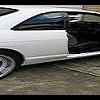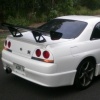Pistons For Your Rb30
Announcements
-
Similar Content
-
Latest Posts
-
And one last super random thought, I remember when SAUNSW had a dinner with Alan Heaphy, and another with Fred Gibson there was talk of the R32 GTR cast alloy uprights failing in racing, and one of the things Fred did when they had to add weight to the vehicle was taken the failing alloy uprights, and have them made of steel. Does anyone remember back to 1990/1991/1992 and WHAT was failing in the front hubs/uprights?
-
If you truly want to know how the original failed though, was it a factory defect possibly etc, send it off for investigation. Would probably cost a shit tonne. The ones that you need to win lotto for, unless you have a good reason for that part to be bolt on, I'd probably roll with getting a few small stitch welds carefully put in place as an extra safety factor once everything is all torqued up tight
-
Are you sure? Because I wouldn't necessarily be. Do we even know the material they've made the new uprights from? Looking at the fractures in the earlier pics, it does to me look like both a twisting, and levering upward action doing the damage, so you're hoping for both compression, and tension. Depending on the bolts, they can stretch (even high grade bolts will) and now you're hoping for the threads themself not to stretch, as if they do, bye bye mating surfaces holding together, hello bolts now going into shear.
-
Lets say I wanted to buy this, specifically for this purpose. How do I actually perform the function. Can I still buy a Consult-1? Am I about to be burned by the fact my car is a 2000 model Series 2 R34 and thus will be some stupid other system? Do I just need this -> https://obd2australia.com.au/product/nissan-consult-14-pin-to-usb-ddl-diagnostic-interface-with-ftdi-ft232r-chip/ And with what software?
-
That's probably OK. That's a face to face compression joint between two surfaces with the clamping load provided by those bolts. So.... it's unlikely that the bolts will end up feeling that load in shear, unless the clamping surfaces are not large enough, bolts not got enough tension on them, etc etc to prevent the two faces from moving wrt each other. Which... I would hope the designers have considered, seeing as it's probably one of the most important things the upright has to do apart from resist collapsing in its own right. But yes, it would definitely be worth asking them what their safety factor on that part of the design was. I tend to think that the casting, being a casting, is not necessarily the strongest bit of material in the world. It's about an inch square, and when you think about the loads that are being put into it, you have to wonder what safety factor the Nissan boys (and every other OEM engineer who has designed all the millions of other uprights that look essentially the same) used to account for defective casting, aging, severe impacts on the wheel, etc etc.
-







Recommended Posts
Create an account or sign in to comment
You need to be a member in order to leave a comment
Create an account
Sign up for a new account in our community. It's easy!
Register a new accountSign in
Already have an account? Sign in here.
Sign In Now